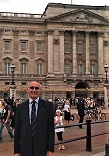


|
|
|
|||||||||||||||
|
|
||||||||||||||||
|
|
|||||
|
|
London Buckingham Palace
The land on which the Palace stands first came into Royal ownership when it was acquired by Edward the Confessor but was given to Geoffrey de Manderville by William the Conqueror. Geoffrey bequeathed it to the Monks of Westminster Abbey and during Medieval times they used it as arable land. The crown was to re-acquire the land through Henry VIII in 1536 and he created a park which he stocked with dear as his own personal hunting ground. The first house on the site was Blake House which was erected by Sir William Blake in 1624. The next owner, Lord Goring, extended it and in 1633 it became Goring House. In 1668 it was acquired by Henry Bennet (Earl of Arlington), the Secretary of State to Charles II. This house was destroyed by fire in 1674 and was rebuilt as Arlington House. In 1698 Arlington House was rented by John Sheffield who became the Duke of Buckingham and he was to purchase it in 1703, where upon he demolished the existing building and rebuilt it as Buckingham House. In 1762 Buckingham House was acquired by King George III (1760 – 1820) at a cost of £21,000 as a private residence. The house was originally intended as a private retreat for the royal family, and in particular for Queen Charlotte, and was known as The Queen's House. At that time St. James's Palace remained the official and ceremonial royal residence, although Buckingham House was developed over the years, particularly by George IV. Buckingham House became the principal Royal residence in 1837 when Victoria ascended the throne. It was she who greatly extended and improved the building creating the Palace that we see today. She added the front wing in 1847 in order to provide more space. This wing was designed by Edward Blore and was originally built of Bath Stone but was refaced in Portland Stone in 1913. It is this wing that contains the famous balcony where the Royal Family appear on many of the occasions relating to the Nations significant events. 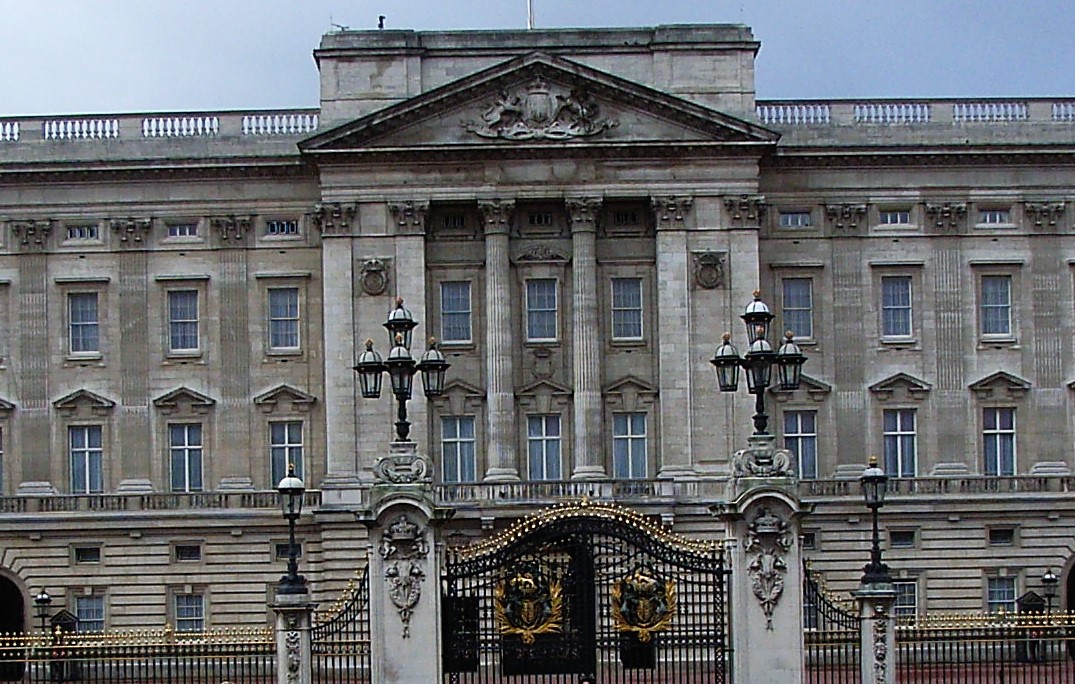 The front façade is known throughout the world and is famous for the changing of the guard’s ceremony which is held there. In front of the Main entrance is the Monument to Victoria placed there a decade after death in 1911. Paying visitors enter the palace via the entrance used by Ambassador’s and is known by the name of the Ambassadors Entrance. 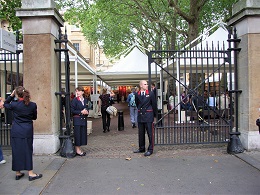 This is located on the left side looking at the front façade. Guest attending official functions and those attending Garden Parties use the Grand Entrance. The Ambassadors’ entrance was designed by Edward Blore who, along with John Nash, designed many of the State Rooms. The Palace contain 19 state rooms which are included in the public tour. Regrettably photography is not permitted, which is the reason no internal photographs are included with this article. On entry visitors go first to the Grand Hall, this was the original entrance and is lit by a shallow dome. Apart from paying visitors, more than 50,000 people visit the palace each year for lunches, dinners, receptions and Royal Garden Parties. Guests for Garden Parties ascend a few steps and pass through the Marble Hall and the Bow Room and into the garden. Paying visitors ascend the Grand Staircase lined with pictures of previous Royalty and passing through the Guard Chamber enter the Green Drawing Room. Before the Palace was extended by Victoria this would serve as a reception and a dining room. The next room is the Throne Room which is used for Formal addresses and photos and where the Coronation Chairs are. It is here, on the throne dais, that royal wedding portraits and family photographs are taken. From the Throne Room visitors move into the Picture Gallery, a 50-metre-long corridor with a glazed vault. This room contains paintings by Rembrandt, Rubens, van Dyke and the largest collection of Canaletto’s in the world. The room is used for dinners. Visitors then progress through a number of rooms before arriving at the Ballroom. When constructed by Victoria in the 1850’s it was the largest room in London. First used to celebrate the end of the Crimean War in 1855 today it is also used for concerts, dinners, and investitures. Progression is then through the State Dining Room, the Blue Drawing Room, the Music Room and the White Drawing Room, all of which contain some beautiful décor and furnishings. Returning to the Ground Floor visitors will pass through the Bow Room and exit into the Garden. 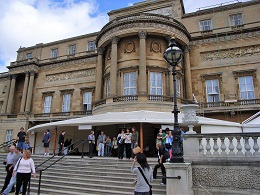 The Gardens consist of 30 acres and were originally set out by Capability Brown although they were redesigned by John Nash. It is the largest private garden in London and contains a manmade lake which was completed in 1828, with water from the Serpentine. At a garden party attendees have free access to the whole gardens, although those who are doing the official tour end with a walk along the south side of the garden to the exit via the souvenir marque, which is erected during the period that paying visitors are permitted. In addition to the palace itself, visitors can also visit the Queens Gallery and the Royal Mews. The Queens Gallery was constructed forty years ago on the west front of Buckingham Palace out of the bomb-damaged ruins of the former private chapel. It was reopened by The Queen on 21 May 2002 and is now open to the public on a daily basis. It contains changing exhibitions of items from the Royal Collection, a large collection of art and treasures held in trust by the Monarch for the Nation. 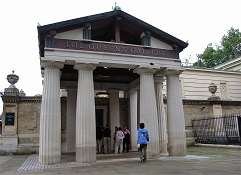 The Royal Mews was started by King George III and is one of the finest working stables in existence with stabling and a training area. 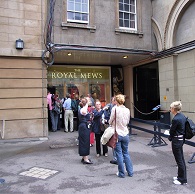 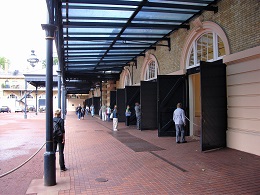 It contains a permanent display of State vehicles and includes the carriages used for Royal occasions, State Visits, weddings and the State Opening of Parliament. It also includes the magnificent Gold State Coach which is the oldest coach in the collection and was first used by George III when opening Parliament in 1762. 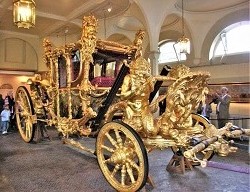 |
|
|||
|
|
|||||
All Photographs were taken by and are copyright of Ron Gatepain
| Site Map |
